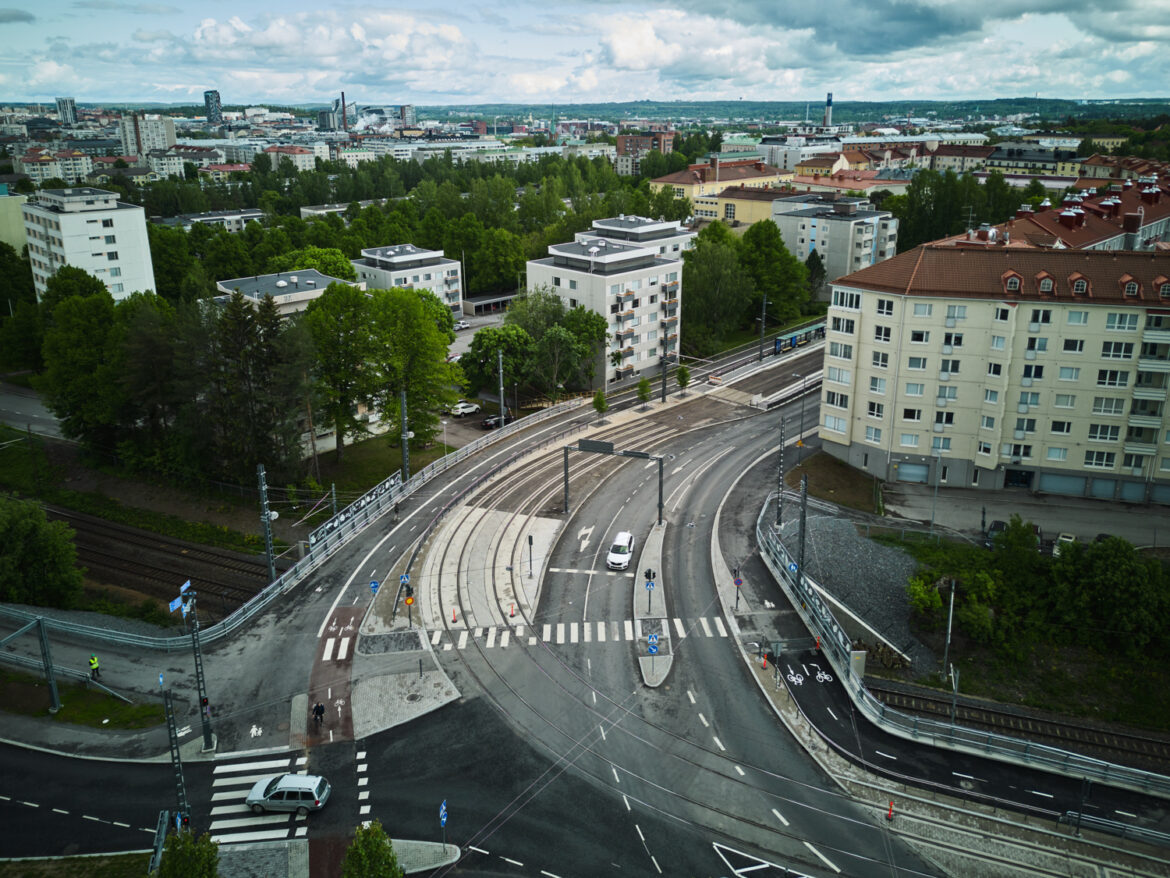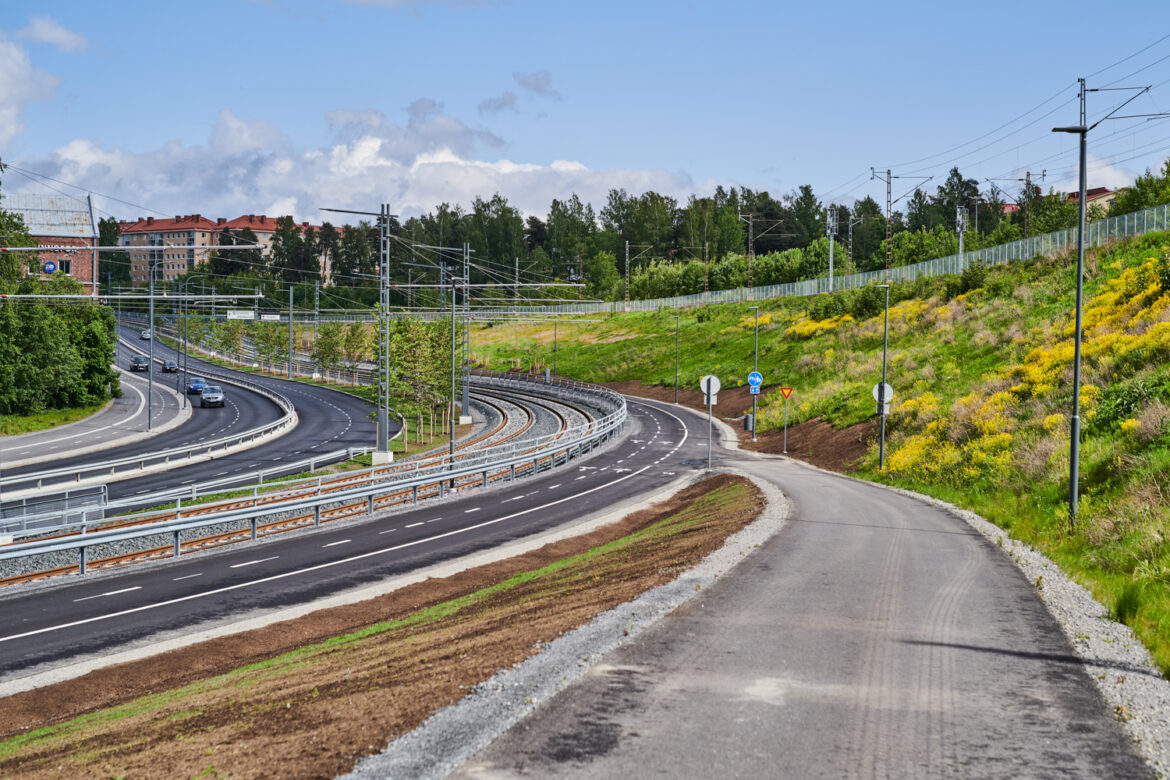Tampere tramway’s Pyynikintori–Santalahti section and all its street sections are ready – test drives will be conducted before the start of traffic
The section of the Tampere tramway between Pyynikintori and Santalahti has been completed today. The renovated street structures have already been taken over by the City of Tampere earlier, and the tramway was transferred to Tampereen Raitiotie Oy during the acceptance testing held this morning.
- We completed the work on schedule and are very pleased with the result. The track is now ready for future test runs and the start of traffic on 7 August. Says Sari Valjus, Project Manager of the Tramway Alliance.
The construction of the tramway between Santalahti and Lentävänniemi has also progressed in accordance with the objectives.
- This year, all other rail installations will be completed, except for the Näsisaari section, which will be completed next year. Work on all three bridges in Näsisaari is also underway, and they will also be completed during next year. The railway and street construction work is planned to be completed in 2024, and it is possible that traffic to Lentävänniemi will start in the beginning of 2025, says Valjus.
The length of the tramway between Pyynikintori and Santalahti is about two kilometres. The construction of the tramway section began in November 2020, immediately after the City Council of Tampere had, earlier in October, approved the construction of the second section of the Tampere tramway. By decision of the council, the tramway will be implemented in stages, in such a way that the section from Pyynikintori to Santalahti will be completed first. After Näsisaari’s permit issues were solved, work on the Santalahti-Hiedanranta-Lentävänniemi section began in March 2022.
Before the start of passenger traffic on the Pyynikintori–Santalahti section, the tramway line and all its structures will be tested. Tampere Tramway and the Tramway Alliance will provide separate information on the timing of the test runs.
In addition to the tramway, a new street environment has also been built
In addition to the construction of the tramway and its systems, all the street areas to which the tramway is connected have also been renewed.
- In addition to the construction of the railway and street structures, a truly significant amount of municipal engineering of the section was also replaced, i.e. water and sewerage networks, stormwater systems, electricity and heat networks, and telecommunications cabling, says Olli Tuomisto, the Tramway Alliance’s Site Manager of Santalahti.
According to Tuomisto, the work, which has lasted less than three years, has progressed well, as a whole.
- The big goal will be achieved, which means that tram traffic can be started as planned. I would like to thank all the residents and operators in the area for their good level of cooperation during the construction, Tuomisto sums up.
On Sepänkatu, the tramway runs in its own lane on the eastern side of the street. Alongside the tramway, there is one lane in both directions for car traffic, and there is also a preselection lane on the Sepänkatu bridge. The pedestrian and cycle routes on Sepänkatu have been reconstructed in such a way that there is a separate pedestrian and cycle route on the eastern side of the street and a sidewalk on the western side. At the turn of June-July, a pedestrian and cycling connection will be introduced from Sepänkatu to the south of Paasikivenkatu. The tram stop on Sepänkatu is called Särkänniemi, and there is a cycle parking area near the stop.
In addition to street construction work, the Sepänkatu bridge across the railway was renewed and widened along Sepänkatu. The new bridge is designed for tram traffic, cars, pedestrians and cyclists. The widest width of the bridge is over 40 metres, while the width of the old bridge was just over 15 metres.

On Paasikivenkatu, the tramway is located in the area between the railway and the roadway. The roadways and lane arrangements on the street have been renewed in accordance with the street plans of the tramway. Paasikivenkatu has two lanes in both directions, and new pedestrian and cycle routes have been built on both sides of the street. Paasikivenkatu has been landscaped along the tramway, and plenty of new trees and bushes have been planted in the area, and green spaces have been built along the track. The tramway electricity supply station is also located on Paasikivenkatu.

On Rantatie, the tramway is located on the north side of the street and the car traffic road on the south side. On the south side of the street there is a sidewalk and a separator with trees and on-street parking. Almost all the way down the street, cyclists must use the roadway. There will be roundabouts at both ends of the street, where cycling will also be directed from separate routes to the roadway. On the east and west sides of the roundabouts, cycle traffic is directed to its own routes. In connection with the tramway, a new pedestrian and cycling connection across Paasikiventie from Rantatie has been built, the Santalahden rantasilta bridge. The bridge replaced the earlier wooden overpass. The renovation of the Santalahden rantasilta bridge was one of the first stages of the Pyynikintori–Santalahti tramway section. In addition to the new overpass, the Rantatie overpass has also been modified so that the tramway can pass under the bridge.
There are two other tram stops on the Rantatie stretch: on the east side is the Tikkutehdas stop and on the west side, at the Santalahden rantasilta bridge, is the last stop of the stretch, Santalahti. Both are side platform stops, which means that there are separate platforms for both directions. There is also a bus stop on the Paasikiventie side adjacent to the Tikkutehdas stop.
In connection with the construction of the tramway, the Tramway Alliance has built a total of more than 2.7 kilometres of new pedestrian and cycle routes between Pyynikintori and Santalahti on Pirkankatu, Sepänkatu, Paasikivenkatu and Rantatie. In addition, many new trees and bushes have been planted along the streets during the construction.
Construction between Santalahti and Lentävänniemi proceeds as planned
The construction of the tramway will continue between Santalahti-Hiedanranta-Lentävänniemi for the rest of the year. The Rosenlew bridge across Paasikiventie and the Ollinoja bridge, built in Sellupuisto, will be completed this year in terms of structures. Work on the Pölkkylänsilta bridge, to be built on the eastern side of Näsisaari, will continue with moulding and reinforcement work, and the casting of the bridge’s deck is planned to take place in late summer. On the west side of Näsisaari, moulding and reinforcement work for the Hiedansilta bridges will be carried out, as well as casting work during the autumn.
The finishing work of the Paasikiventie additional lane will continue in Santalahti for the rest of the summer and will be completed in the autumn. In addition, surface structure work will be carried out in the Paasikiventie and Rantatie areas. As the work progresses, a few lane arrangements will be made in the Paasikiventie area, and the final asphalt paving of the areas under construction will be completed in the autumn. The junction of Rantatie with Paasikiventie from the west will be restored at the end of the summer. At the western end of Rantatie, pedestrian and cycle traffic will be directed through a roundabout that will reach its final location during the autumn, and the temporary pedestrian and cycle route running along the side of Pispalanharju will then no longer be in use.
Railway installations continue in Hiedanranta, as well as the construction of stop areas at the future Hiedanranta transfer stop, the Tehdas stop and the Niemen kartano stop in Sellupuisto. Rails will be made in the Hiedanranta area, track slabs will be installed and later in the autumn the rail installations of the ballast track sections will also start. The work at the Hiedanranta and Sellupuisto electricity supply stations will be completed during this year. The Hiedanranta pedestrian and cycle route has been modified to cross the track area. Traffic arrangements are managed by Hiedanrannan Kehitys Oy, which builds, for example, future residential blocks and related municipal engineering in the area. In Hiedanranta, the aim is also to start the tramway’s electric track work at the end of the year, i.e. the fitting out of the electric track poles and the installation of the overhead line.
In the Niemenranta and Lentävänniemi areas, all track and stop work will be completed during the rest of the year, with the exception of paving. At the last stop of Pyhällönpuisto, the building of the ballast track section has already started in early summer. Plenty of paving and street construction work will be carried out on tramways this year, and it will be completed during next year. Starting from the end of June, electrical track works will also be carried out in the Lentävänniemi area, i.e. the fitting out of electric track poles and the installation of overhead contact lines. In addition, the technical systems required for the tramway will be installed. New bus stops are also being built in the Kehyskatu roundabout area in accordance with the street plan.
All traffic arrangements and the other effects of roadworks and night work during the construction will be announced on the Tramway Alliance’s website. Information about the effects on public transport is provided by Nysse. Tampere Tram will provide more information about the art on and future plans for the tramway.